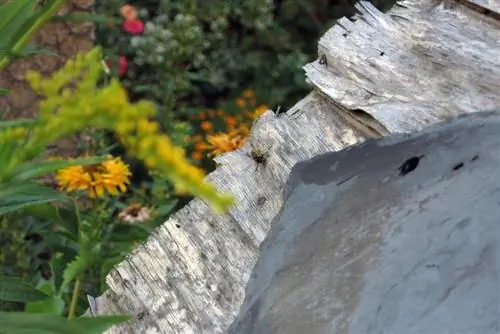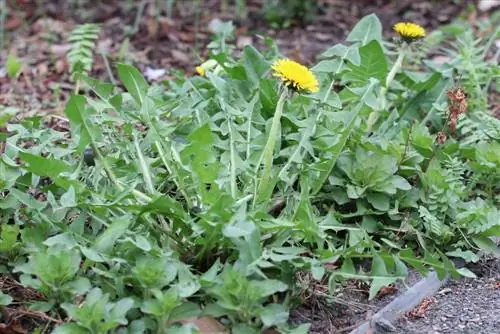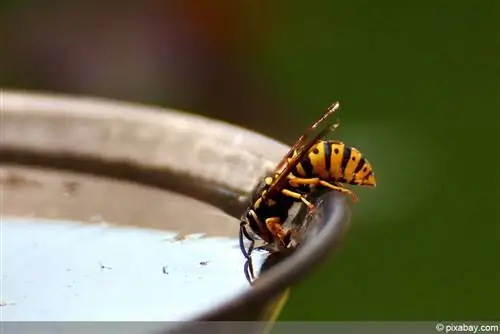- Author admin [email protected].
- Public 2023-12-17 03:39.
- Last modified 2025-01-24 12:45.
" Getting rid of" by itself is a bit imprecise because you can certainly get rid of a pile of pulp on the wall without advice. If you would like to know when wasp nests might still be inhabited, whether a wasp nest absolutely needs to be removed or whether old wasp nests encourage new queens to build nests, you will find comprehensive information below:
Little wasp nest knowledge
Before you start removing a wasp nest somewhere in a hidden corner of your home, it would certainly be useful to know whether this nest is empty. The fact that the majority of wasps are no longer buzzing around the nest can be determined by visual inspection from a distance. But you probably want to be sure that you don't encounter a single wasp during the removal and cleanup operation, neither stragglers nor an overwintering queen.
The chances of this happening depend on how big the nest is and when you last noticed activity around the nest. Small nests that haven't been buzzing around for a while in October will almost certainly be empty by the beginning of November and can be eliminated. These nests are left by short-lived wasp colonies that died at the beginning of autumn. With these small nests it is also quite possible that you will notice the nest for the first time in winter - the small colonies of often dark-colored wild wasps are not aggressive and avoid (fly) people as much as possible.
The conspicuous, larger nests, which seem to be worth thinking about what's going on inside this artfully nested structure, are structures of our most "annoying" wasp species, the "common wasp" and the "German wasp". You probably won't notice these nests until winter, because there was a lot going on there from May onwards: the queen started building the nest in May, wasps could be seen arriving and leaving from time to time over the summer, and it was late summer then some hustle and bustle around the nest. For good reason, from September/October the wasps of these species slowly die and shortly beforehand become more and more aggressive.
By November at the latest it should have become quiet around a wasp nest of some size; If you haven't seen any flying wasps for several days and the first night frosts have passed, you can be sure that the wasp nest is now empty. The wasp colony has now died; the only survivor is the queen, who hibernates to build a new nest next year. For you this means: Clean air, because the queen does not overwinter in the old nest, and she does not use the old nest again, but always builds a new nest.
Here are a few nice pictures of the nest building art of our most common species: www.aktion-wespenschutz.de/Wespenarten/Deutsche%20wespe/germanicaUnten.htm, www.aktion-wespenschutz.de/Wespenarten/Gemeine%20wespe/vulgarisIndex. htm.

Just for the sake of completeness: Before winter, when the nest is still full of life, you should not simply remove it. Wasps are useful to our society because they pollinate plants and plants are the basis of our diet; for your garden, because they ensure that populations of harmful insects remain at acceptable levels, for you, because they ensure flowers in the garden and are responsible for ensuring that the house and garden are not overrun with other unpleasant animals. That's why wasps are protected, according to § 39 BNatSchG, any deliberate disturbance of wasps (and other wild animals) is prohibited, wasps may not be caught, injured or killed without a reasonable reason, and their habitats may not be impaired or destroyed without a reasonable reason. It is not up to you personally to determine whether there is a reasonable reason - but in the event of a conflict you will receive help from many sides, and if in doubt your local environmental office will show you the way.
Remove wasp nest
An old wasp nest can be removed in winter if no wasps have been seen nearby for a long time. This is the quickest way to do it and with the least amount of dirt:
- Provide a vacuum cleaner, preferably with someone willing to use it, of course
- You will also need a large (blue) garbage bag
- A sharp knife or a wide flat spatula, depending on the size of the nest hanger
- A brush, depending on the material under the nest made of wire or bristles/plastic
- Put the bag under the wasp nest
- Cut or prick the wasp nest so that it falls into the bag
- Freed from thinking about rumors about wasps remaining in the nest/overwintering queens
- Brush as much of the remaining wasp nest residue on the wall/in the roller shutter box as possible into a bag
- Dispose of the garbage bag, brush away and vacuum away residues that are harder to reach
That's it, then you can thoroughly clean the nesting area with a damp cloth so that the familiar smell doesn't encourage the next queen to build a nest. But clever queens will always find uniquely suitable places, which is why you should think briefly about whether the nest definitely needs to be removed from a place where it won't be too disturbing.
Old nest, new nest?
There would be an argument for not removing the wasp nest until next spring: the queen overwinters somewhere nearby, and when she sets out to create the new nest next spring, she will look for the optimal place, just like last time. If the spot you chose last time is the only spot where a wasp can build a nest in peace, it would make sense to leave the nest hanging until spring. Because the biologists are pretty sure that it has never happened before that a queen wasp moves into an old nest.
However, this decision requires an assessment of the environment “from a wasp’s perspective”. People can even imagine some of the criteria that play a role in choosing a location for the nest: nice and quiet, an opportunity to get outside into the garden, empathetic people have fun with it and think about it a little further. If it turns out that the shutter box (with the old wasp nest that needs to be removed) is the only place where a queen wasp can reasonably build a nest in that room, you can leave the nest hanging until spring and be safe Make sure that wasps don't move in again next year.

For animal lovers or ecologically interested people, there are other reasons for not removing an abandoned wasp nest immediately:
- If you want to ensure “more ecology in the area”, leave the nest hanging for secondary use
- Many insects like to use the artfully constructed wasp nests as overwintering quarters
- Mostly they are beneficial insects such as lacewings that destroy house dust mites and houseplant-eating aphids
- If you have already learned to appreciate wasps as pest controllers:
- Even if no new queen will move into the old nest, it spreads a “homely smell”
- If there is e.g. B. the garden shed gives even more opportunities to build a nest, other queens may build nests there
- This is particularly likely in small, free-hanging nests of “non-annoying wild wasp species”
- Such peace-loving wasps do not bother you even if you have multiple settlements, but only eagerly eat insects
- These mini nests e.g. B. the house field wasp show an open structure
- It is even said that the wasps use the nest for several years
Prevent new nest building
If the nest is not in the garden shed but in the house, but nature would rather stay in the garden, the nest will be removed. After the final wet cleaning with hygiene cleaner, which ensures that “foreign wasps” no longer sniff familiar smells, you can odorize the area in question so that it becomes unattractive to wasps: most wasps should not like lavender, cloves, incense and lemon like; Some essential oils that don't exactly smell like native plants, such as eucalyptus, manuka, niauli and patchouli, are certainly worth a try.
But you are dealing with living beings who are taking care of the most important task of all (preservation of the species), if the rooms you “offer” are great nesting places for wasps, this will probably happen again and again with free access once a queen strays to you.
“Free access” for a wasp is already given to very small cracks, but you can of course try to make your house a little more “wasp-proof”:
- Install as many fly screens as possible
- Completely normal models are sufficient, expensive special installations rarely bring more
- If you have a lot of traffic from the house to the garden in the summer months, it is worth installing automatic door closers
- If the door to the garden is constantly open just so that the dog or cat can come in and out, a dog or cat flap might be an idea
- Openings of roller shutter boxes can be closed against wasps
- Wooden beams should no longer be chosen as a nesting place by wasps when they are painted
- If you don't want that, you could look into wasp deterrent waxes and oils
- Wasps should not nest under the eaves if the gutters are made of copper

If prevention fails, or the wasps in your area are particularly stubborn, you can stop the establishment of wasp nests in the spring: from the beginning of April, the queens of the German wasp are out looking for nests, and from mid-April the queens are out the common wasp, the queens of other wild wasp species later in the spring. The workers do not appear until May when the nest is ready, so queens fly around lonely and alone. But they are quite easy to recognize, namely “mighty buzzers”, 4 mm longer than normal wasps and thick and round.
Now you probably have better things to do than looking for wasps flying around all day long - you don't have to, a little attention in the "threatened" area is enough. Because then you won't miss when a queen wasp starts building a nest. The quicker you discover them, the easier it is to destroy the work you've started. The wasp queen will then leave her home in frustration and start building her nest again in a more hospitable place.
Conclusion
There are surefire remedies for wasp nests in the house, but they can all be used in the garden. Surround your property with a “ring of nature” on the outer edge: hedges with trees in between that invite insects to build nests, insect hotels built in front of or in between; and if you want peace and quiet from wasps forever, all you have to do is get a few hornets. The inhabitants of a small hornet nest, around two dozen animals, are said to eat tens of thousands of wasps in one summer. As pure insect eaters, hornets are hardly a nuisance for humans; a nest in the garden is often unnoticed all summer long. You can “get” hornets by building them a suitable insect hotel, or, even better, by converting the disused, half-rotten bird house in the back of the garden into a hornet apartment. This conversion is quick: one or two euro-sized holes in the floor, and the hornets (who need passage in the house to regulate the temperature in the hive) are happy with the offer. Bumblebees and wild bees also like such dwellings, which in our times of need for insects are also “a good ecological deed”.






